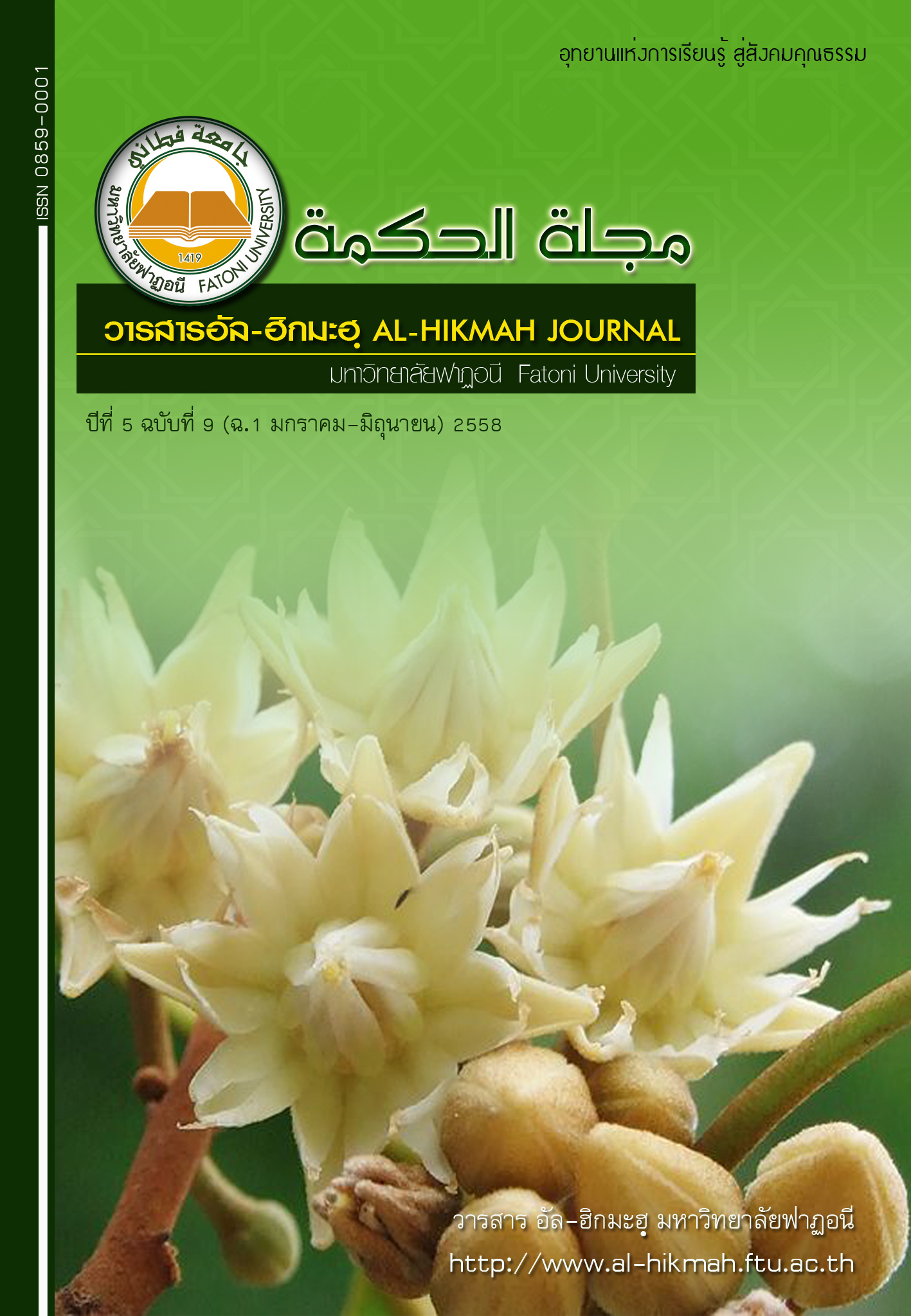The Control of The Offenders in The Temporary Release With Electronic Monitoring
Keywords:
The Temporary, The Control of The Offenders with The Electronic MonitoringAbstract
The objectives of this research are to study (1) whether the controlling of the offender in the temporary release by electronic monitoring can be used to protect both the rights of the culprits or the defendants who are accused and the peace of society or not; (2) principles, forms, methods, and instructions of the law to control the offenders in the temporary release by electronic monitoring; (3) control measures by electronic monitoring for those inmates who try to escape during the temporary releasing. In this study, a qualitative research has been employed by analyzing the documents and field research with in-depth interviews.
The research findings indicate that temporary release is being used to ease limitation for the defendants' rights and liberties on trial. In this case, there are 3 typical temporary releases i.e. the temporary release without bond, the temporary release with bond, and the temporary release with both bond and bail. However, in practice the judiciary or the court officers mostly employ the temporary release with valuable bail and high surety bond to ensure that the defendant will be present within their jurisdiction while on furlough. This practice affects to the first problem in the equality acts for those who are in a bad economy since the ones who have better economic background gain higher opportunity for the temporary release than the poor ones. The second problem from this effect is on the bail bonds business by which the bondsman can take advantage on the poor accused defendants particularly in hiring a 'surety bond' for their temporary release. The next problem is on the defendants' liberties particularly in terms of providing evidence to the court and losing opportunity to earn a living and to take care their family. The further problem is on the judicial discretion towards the exercise of considering the temporary release. This research therefore takes the issues listed above of temporary release into account in order to analyze whether the electronic monitoring can be used to control the defendants in the temporary release in order to solve such problems, and to protect the rights and liberties of the defendant accused, the victims, and the witness in criminal cases, as well as to ensure the peace of the society. The policy of temporary release by electronic monitoring to control the defendants should be introduced with principles, forms, methods, and instructions including the legal standards to prevent a fleeing defendant that are appropriate to the context of Thailand.
With respect to the protection of the rights and liberties of the accused persons, the research findings indicate that using electronic monitoring as an alternative in the temporary release enhances the opportunity to exercise the temporary release for the accused defendants, particularly for those who are poor they should be financially supported by the government for the expenditure from the electronic monitoring that might be occurred to make the equality to the poor defendants. With respect to the protection of the rights and liberties of the victims and the witnesses in criminal cases and the peace in nation, the research findings indicate that the electronic monitoring can program the conditions for the defendants to follow in the temporary release. These conditions can protect the victims and the witnesses in criminal cases from the threat by the accused defendants, as well as can prevent the recidivism.
With respect to principles, forms, methods, and instructions of the law including the legal standards to prevent a fleeing defendant; the research findings indicate that using electronic monitoring in the temporary release can be employed with any kind of cases from the inquiry official level, the prosecutor, and the court trial. It can be applied for the ordinary person who commits offend for the first time, or has no risk to escape, or has no threat or harm to other persons or their properties, or unlikely to commit a felony crime or recidivism, and has no risk to threaten the witness nor oppose to the justice system. In addition, the legal standards to prevent a fleeing defendant should be introduced as a criminal offense.
References
กิตติพงษ์ กิตยารักษ์. 2546. “ยุทธศาสตร์การพัฒนากระบวนการยุติธรรมเพื่อคนจน,” เอกสารประกอบการสัมมนาทางวิชาการ เรื่อง แนวทางการสร้างความเสมอภาคและความเป็นธรรมทางกฎหมายสำหรับคนจน, ณ เนติบัณฑิตยสภา. ม.ป.ท.
กุลพล พลวัน. 2538. พัฒนาการสิทธิมนุษยชน. หน้า 48-49. กรุงเทพมหานคร : สำนักพิมพ์วิญญูชน.
จรัล ดิษฐาอภิชัย. (2 กรกฎาคม 2546). “การส่งเสริมสิทธิของคนจนในกระบวนการยุติธรรม,”เอกสารประกอบการสัมมนาทางวิชาการ เรื่อง แนวทางการสร้างความเสมอภาคและความเป็นธรรมทางกฎหมายสำหรับคนจน, ณ เนติบัณฑิตสภา.
ทักษิณ ชินวัตร. 2546. “ความยุติธรรมกับความยากจนในทัศนะ ของนายกรัฐมนตรี”. เอกสารประกอบการสัมมนาทางวิชาการ เรื่องแนวทางการสร้างความเสมอภาค และความเป็นธรรมทางกฎหมายสำหรับคนจน, ณ เนติบัณฑิตยสภา.
นพนิธิ สุริยะ. 2537. สิทธิมนุษยชน. หน้า 159. กรุงเทพมหานคร: สำนักพิมพ์วิญญูชน.
บัญญัติ วิสุทธิมรรค. (พฤษภาคม, 2533). “การประกันตัวผู้ต้องหาชั้นพนักงานอัยการ,” วารสารอัยการ 13: 22.
เบ็ญจะ เพ็งดิษฐ์. 2531. การคุมขังผู้ต้องโทษนอกเรือนจำโดยอาศัยเครื่องมืออิเล็กทรอนิกส์. “งานนิพนธ์” วิทยานิพนธ์มหาบัณฑิต. คณะนิติศาสตร์: จุฬาลงกรณ์มหาวิทยาลัย, ถ่ายเอกสาร.
รวีวัฒน์ ชวนมณีนันท์. 2544. มาตรการหลีกเลี่ยงการควบคุมผู้กระทำความผิดตามข้อกำหนดโตเกียว: การนำมาใช้ในประเทศไทย. “งานนิพนธ์”วิทยานิพนธ์มหาบัณฑิต คณะนิติศาสตร์: มหาวิทยาลัยธุรกิจบัณฑิตย์. ถ่ายเอกสาร.
วรวุฒิ ทวาทศิน. (2 กรกฎาคม 2546). การสร้างความเสมอภาคในการปล่อยชั่วคราว,”เอกสารประกอบการสัมมนาทางวิชาการ เรื่อง แนวทางการสร้างความเสมอภาคและความเป็นธรรมทางกฎหมายสำหรับคนจน, ณ เนติบัณฑิตยสภา,
สิทธิพร บุญคุ้ม. 2550. “การคุ้มครองสิทธิเสรีภาพของผู้ต้องหาและจำเลยในคดีอาญาโดยการปล่อยชั่วคราว,”. “งานนิพนธ์” ดุษฎีนิพนธ์ นิติศาสตรดุษฎีบัณฑิต คณะนิติศา: มหาวิทยาลัยรามคำแหง. ถ่ายเอกสาร.
สิทธิศักดิ์ วนะชกิจ. (ตุลาคม-ธันวาคม, 2539). “ข้อพิจารณาการสั่งคำร้องขอปล่อยชั่วคราวและมาตรการที่ใช้ในการปล่อยชั่วคราวผู้ต้องหาและจำเลยที่เป็นเด็กหรือเยาวชน,” ดุลพาห 43: 58.
สุทธิณัฐ ไชยเจริญ. 2549. “การปล่อยชั่วคราวโดยศาล: ศึกษาความเสมอภาคที่ได้รับจาการปล่อยชั่วคราว,”. สารนิพนธ์นิติศาสตรมหาบัณฑิต: มหาวิทย



